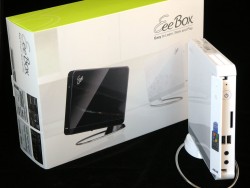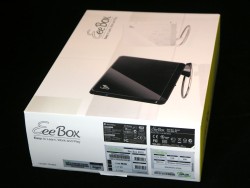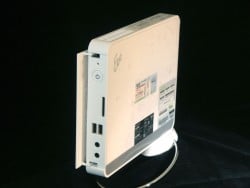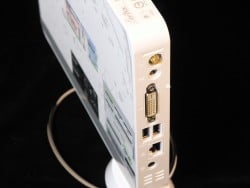Asus Eee Box B202 Desktop System Evaluation
A Closer Look and The Eee Box BIOS

There's no question, the Asus Eee Box is a sleek small form-factor PC that is both diminutive and stylish all at the same time. With its clean, white construction, this machine is small enough and stylish enough for counter-top placement, or perhaps within the confines of a home theater setup.
The front side of the system is concealed with a trim cover door that opens to offer access to the power button, HD activity indicator light (both of these shine through the door), an SD/MMC flash card reader, two USB 2.0 ports, a headphone jack and microphone jack. On the back side of the system is the 802.11n WiFi screw terminal (antenna not mounted here), power jack, DVI output, two more USB 2.0 ports, a Gigabit Ethernet port and the system's stereo / S/PIF line output jack. Though the Eee Box's casing is plastic, the system has a firm, sturdy feel and it seems to be made of quality materials. The front trim door did feel a little flimsy, however.
Though we didn't venture into a full tear-down of the Eee Box, we did pull the system's top cover off, as well as pull its hard drive, in order to show you a couple of its upgrade options. Getting inside the Eee Box is fairly simple task, if you're delicate enough with a standard flat-head screw driver in order to pull off the top side skin. For storage options, the Eee Box we tested came equipped with a standard 2.5" low power Seagate 80GB mobile hard drive. You could conceivably upgrade any Eee Box with a larger hard drive just by pulling a couple of screws and sliding out the drive bay. Also you can see the system uses standard notebook SODIMM modules and as such you also could upgrade the system with higher density DDR2 modules, versus the 2x512MB configuration we tested. On a side note, as you can see in the close-up shot, the Eee Box comes standard with 400MHz memory. Finally, as you can see with the system sitting next to an iPod Nano, the Eee Box about the smallest full function PC we've ever seen to date.
Upon re-assembly of the system, we powered it back up and dove into its BIOS menu options to have a look around. Surprisingly, or perhaps not with Asus' long lineage of overclocking features, the Eee Box is fairly "tweakable" here.
The Emulation Type menu could come in handy if you're interested in working with external USB storage devices as bootable volumes. This will allow you to set device types as either standard FDD drives or Hard Disk type drives. In terms of system memory, you can see the Eee Box also supports DDR2-533 memory as well, with both 400MHz and 533MHz options available. In fact, perhaps the best upgrade option you could look at for the Eee Box would be a 2GB SODIMM DDR2-533 kit. In addition, you have the option of adjustable memory timings as well. Also, in the Eee Box BIOS you're presented with options for overclocking not only the system's Atom CPU but also the Intel GMA 950 graphics core of the chipset...
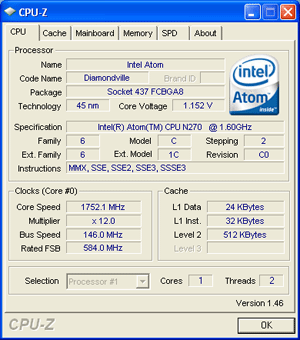

Intel's Atom, jacked to 1.75GHz
At the BIOS menu's most aggressive setting, the Atom N270 processor is overclocked in the Eee Box from its stock 1.6GHz to 1.75GHz and system memory is set to 584MHz from it's stock 400MHz DDR2 clock speed. An interesting notable here is that we never heard fan speeds kick up at these settings and our Eee Box was fully stable for a full benchmark run with PCMark 05.

